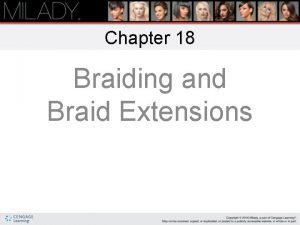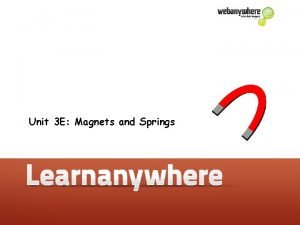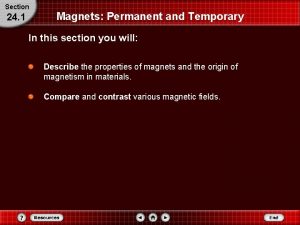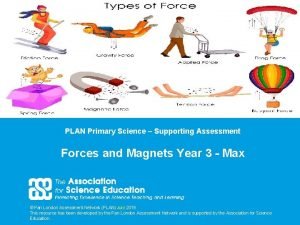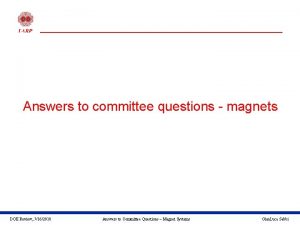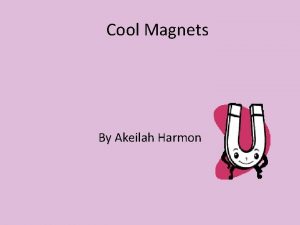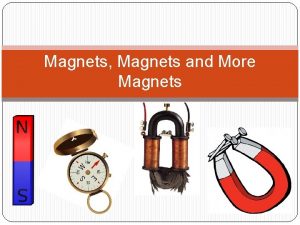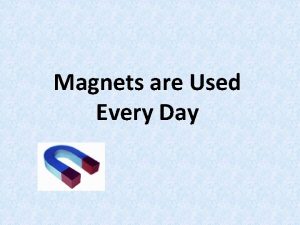Answers to committee questions magnets DOE Review 622011








- Slides: 8

Answers to committee questions - magnets DOE Review, 6/2/2011 Answers to Committee Questions – Magnet Systems

Q 1: Please clarify the definition of success for the operating point vs. short sample limit 1) Background: • Last year following a review recommendation we established a CERN-US working group to discuss requirements and development plans for Nb 3 Sn and present recommendations to LARP, DOE, and CERN management • One of the goals was to articulate a set of “success criteria” for magnet quench performance since it was felt that simply defining a target gradient as it was done for TQ/LQ (200 T/m) would not capture some of the key metrics such as fast training and no retraining after a thermal cycle • Also, in order to apply to any magnet they were formulated relative to a maximum theoretical performance given the magnet design and conductor properties • The committee expressed concern about the statement that Target operational quench level will be defined as 80% of SSL • A wording issue? “Operating point” suggests operation in the machine; “short sample limit” does not have a unique definition DOE Review, 6/2/2011 Answers to Committee Questions – Magnet Systems

Q 1: Please clarify the definition of success for the operating point vs. short sample limit (slide 2/3) 2) Clarification attempt: • This definition of success only applies to quench performance in R&D models – not to the design/expectations for HL-LHC • We define theoretical performance limit as the intersection of the magnet load line (peak field in the conductor as a function of current) and the cable critical current as function of field • The conductor peak field is derived from calculations and the cable critical current is derived from extracted strand measurements using the ITER Ic measurement method • The performance limit as defined above provides a maximum current that the magnet can sustain without quench. We take 80% of this value as a reference point in evaluating the magnet quench performance • The 80% criteria will provide a reference gradient and peak field. • The goals for training/retraining stay the same • We will review with CERN to make sure we are on the same page DOE Review, 6/2/2011 Answers to Committee Questions – Magnet Systems

Q 2: HQ – Please list issues to be addressed and the focused remediation steps The causes of observed performance limitations: • • Coils under excessive compaction during curing and reaction Insufficient insulation between coil and ground Remediation: • • • Reduce strand cable size Room for 4. 5% of azimuthal coil expansion Room for 2. 3% of radial coil expansion Room of 4 mm/m (Island gap size) for coil axial contraction Thicker insulation between layers Improved electrical QA - Impulse test DOE Review, 6/2/2011 Answers to Committee Questions – Magnet Systems

Q 3: How are the HQ and LHQ schedules integrated? (slide 1/2) LQS 03 test HQ coil w new cable tested w mirror HQ 02 w new cable Practice coils Spare coil test Structure develop. & test LHQ 01 coils LHQ 01 assembly & test LHQ 01 b assembly & test LHQ 02 coils, assembly & test DOE Review, 6/2/2011 Answers to Committee Questions – Magnet Systems

Q 3: How are the HQ and LHQ schedules integrated? (slide 2/2) LQS 03 test HQ coil w new cable tested w mirror HQ 02 w new cable Practice coils Spare coil test LHQ 01 coils DOE Review, 6/2/2011 Answers to Committee Questions – Magnet Systems

Q 4: What are the deliverable goals of the magnet program and how are you going to measure them? • Goal of LARP is to demonstrate Nb 3 Sn technology for use in the upgraded IR quads. Therefore LARP will have achieved its goal if the HL-LHC TDR will specify a Nb 3 Sn IR Quad ØClearly we are on the right track since Nb 3 Sn is now recognized as the primary candidate technology for the upgrade • We agreed with CERN that a successful LHQ with 120 mm aperture and ~4 m length will be sufficient to complete this demonstration • We agreed on a set of success criteria for LHQ quench performance • However other key performance indicators/targets are not yet defined: field quality, thermal margin, radiation resistance etc. ØDefining these targets for LHQ is not a goal of the design study, but the design study will help understand what is needed ØDirect comparison between Nb 3 Sn and Nb. Ti models with 120 mm aperture will also be an important decision criteria DOE Review, 6/2/2011 Answers to Committee Questions – Magnet Systems

Q 4 follow up: so why do we discuss infrastructure needs, construction schedules etc? • There seems to be an implicit mandate or expectation that LARP will facilitate the construction planning until it is handed off to a project • Last year’s review contained many recommendations pushing us in this direction. • A legitimate question is whether some of these preparation steps would then become LARP tasks or not • Examples: long infrastructure for the prototype, early conductor procurements, short model of the final design, the prototype itself • Some guidance from the APUL (then LAUC) experience: LARP developed the proposal, but the 2008 DOE review of LARP strongly recommended to form a separate organization asap. • However, there are some important differences in this case since HLLHC IR Quads are fully aligned with LARP while the “Phase 1” scope was not, especially for magnets DOE Review, 6/2/2011 Answers to Committee Questions – Magnet Systems
 Topic 3 review questions civilizations of asia answers
Topic 3 review questions civilizations of asia answers List eight types of facial cosmetics and how they are used
List eight types of facial cosmetics and how they are used List several types of braiding techniques
List several types of braiding techniques Performance review committee enron
Performance review committee enron Magnets for year 3
Magnets for year 3 Magnets and springs
Magnets and springs What happens when you break a magnet in half
What happens when you break a magnet in half Amazing magnets fishing magnet
Amazing magnets fishing magnet Why do magnets repel
Why do magnets repel


